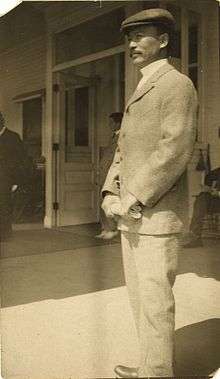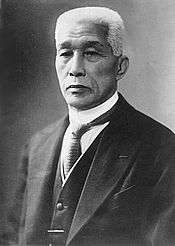Yamashita Yoshiaki
| Yamashita Yoshitsugu 山下 義韶 | |
|---|---|
|
Yamashita Yoshitsugu, first 10th dan judoka | |
| Born |
16 February 1865 Kanazawa, Kaga Province, Japan |
| Died | 26 October 1935 (aged 70) |
| Native name | 山下 義韶 |
| Style | Judo |
| Teacher(s) | Kano Jigoro |
| Rank |
Judo: 10th dan Tenjin Shin'yō-ryū: Complete license |
| Notable students | Theodore Roosevelt; Imperial Japanese Naval Academy; Tokyo Imperial University; US Naval Academy; Tokyo Municipal Police |
Yamashita Yoshitsugu (山下 義韶, 16 February 1865 – 26 October 1935, also known as Yamashita Yoshiaki), was the first person to have been awarded 10th degree red belt (jūdan) rank in Kodokan judo. He was also a pioneer of judo in the United States.
Early years
Yamashita was born in Kanazawa, then the capital of the powerful Kaga Domain. His father was of the samurai class.[1] As a boy, Yamashita trained in the traditional (koryū) Japanese martial arts schools of Yōshin-ryū and Tenjin Shin'yō-ryū jujutsu.[2] In August 1884, he joined the Kodokan judo dojo of Kano Jigoro (嘉納 治五郎 Kanō Jigorō, 1860–1938), as its nineteenth member. He advanced to first degree black belt (shodan) rank in three months, fourth degree (yondan) ranking in two years, and sixth degree (rokudan) in fourteen years.[1] He was a member of the Kodokan team that competed with Tokyo Metropolitan Police jujutsu teams during the mid-1880s,[3][4] and during the 1890s, his jobs included teaching judo at the Imperial Japanese Naval Academy and Tokyo Imperial University (modern University of Tokyo).[1]
The Four Guardians of Kōdōkan
When Kanō Jigorō began to develop judo from jiu-jitsu, his efforts were met with fierce opposition from jiu-jitsu practitioners. However, Kano drew a loyal following that included exceptional fighters. Hence the term "Four Guardians of Kōdōkan" came into existence, referring to Yamashita Yoshiaki along with Tsunejiro Tomita, Yokoyama Sakujiro, and Saigō Shirō.[5]
Introducing judo to America


In February 1902, Seattle-based railroad executive Samuel Hill decided that his 9-year-old son, James Nathan, should learn judo, which he had apparently seen or heard about while on a business trip to Japan. In Hill's words, the idea was for the boy to learn "the ideals of the Samurai class, for that class of men is a noble, high-minded class. They look beyond the modern commercial spirit."[6] Hill spoke to a Japanese American business associate, Masajiro Furuya,[7] for advice. Furuya referred Hill to Kazuyoshi Shibata, who was a student at Yale University. Shibata told Hill about Yamashita, and on 21 July 1903, Hill wrote a letter to Yamashita, asking him to come to Seattle at Hill's expense.[8] On 26 August 1903, Yamashita replied, writing that he, his wife, and one of his students (Saburo Kawaguchi) would leave for Seattle on 22 September 1903.[9]
The ship carrying the Yamashita party docked in Seattle on 8 October 1903.[10] A week later, on 17 October 1903, Yamashita and Kawaguchi gave a judo exhibition at a Seattle theater that Hill had rented for the evening. Attendance was by invitation only, and guests included Sam Hill's mother-in-law, Mary Hill (wife of railroader J.J. Hill), Senator Russell Alger, and assorted Sportswriters.[11] Afterwards, Hill took the Yamashita party east to Washington, D.C., where Mrs. Hill and young James Nathan were then living. Meanwhile, the favorable publicity surrounding the event caused Japanese Americans living in Seattle to start their own judo club, known as the Seattle Dojo.
Soon after arriving in the District of Columbia, Yamashita visited the Japanese Legation, and in March 1904, the Japanese naval attaché, Commander Takeshita Isamu, took Yamashita to the White House to meet President Theodore Roosevelt.[12] Roosevelt practiced wrestling and boxing while in the White House, and he had received jujutsu jackets from William Sturgis Bigelow[13] and jujutsu lessons from J. J. O'Brien, a Philadelphia police officer who had studied jujutsu while living in Nagasaki.[14][15][16] Roosevelt was impressed with Yamashita's skill, and during March and April 1904, Yamashita gave judo lessons to the President and interested family and staff in a room at the White House.[17][18] Subsequently, at other locations, Yamashita and his wife Fude gave lessons to prominent American women, to include Martha Blow Wadsworth (sister of Kindergarten pioneer Susan Blow), Hallie Elkins (wife of Senator Stephen Benton Elkins), and Grace Davis Lee (Hallie Elkins' sister), and their children.[19]
In January 1905, Yamashita got a job teaching judo at the U.S. Naval Academy. There were about 25 students in his class, including a future admiral, Robert L. Ghormley.[20] The position ended at the end of the school term, and Yamashita was not rehired for the following year.[21] When President Roosevelt heard of this, he spoke to the Secretary of the Navy, who in turn told the Superintendent of the Naval Academy to rehire Yamashita.[22] Consequently, Yamashita's judo was taught at the Naval Academy throughout the first six months of 1906.[23]
Later life
At the end of the 1906 academic year, Yamashita left the United States for Japan.[24] On 24 July 1906, he participated in a conference in Kyoto that had been called for the purpose of standardizing judo forms (kata) that could be taught in Japanese public schools.
From the 1910s to the 1930s, Yamashita worked as a judo teacher at Tokyo Higher Normal School (東京高等師範学校 Tōkyō Kōtō Shihan Gakkō).[18] In this capacity, he often attended judo tournaments and exhibitions.[25] He also taught judo to the Tokyo Municipal Police. Thus, from September 1924 to April 1926, Yamashita was part of a committee that developed a new kata for Japanese police.[26]
An example of Yamashita's teaching method is the advice:[27]
| “ | Always try to think of improvement, and don't think that you are too good. The latter is very easy to do while learning judo. | ” |
Yamashita's last major public appearance was probably the celebration of the 50th anniversary of the establishment of the Kodokan, an event which took place in November 1934. British judoka Sarah Mayer described Yamashita's participation as follows:[28]
| “ | One of the Imperial Princes was present and the Emperor sent a present of money. A speech was read from the Prime Minister and the Minister of Education delivered a long oration. All the famous Judo men were there and there was a rather touching scene when Mr. Yamashita, the oldest pupil, came forward. He has lost his voice with advancing years and another man had to read his speech for him, but as he stood facing Prof. Kano I could not help thinking of the long years that these two men, now so old, had struggled to make Judo popular, and what a wonderful day it must be to them to have lived to see such an amazing achievement. Famous men demonstrated beautiful Kata when the speeches were over and Prof. Kano had dedicated three trees to his three teachers, and comic relief was provided by a match between me and Mr. Samura,[29] who was good enough to get the worst of it. | ” |
His ultimate promotion to 10th dan was posthumous.[29]
Video footage
- Koshiki no kata Yoshiaki Yamashita with Jigoro Kano
References
| Wikimedia Commons has media related to Yamashita Yoshiaki. |
- 1 2 3 Tomita, Tsuneo. "Histoire du Judo," Revue Judo Kodokan, November 1962, v. 12:5.
- ↑ Sol, Kim. "Part 8: Kodokan Becomes an Organization."
- ↑ Abel, Laszlo. "The Meiji Period Police Bujutsu Competitions: Judo versus Jujutsu," JMAS Newsletter, December 1984, v. 2:3, pp. 10–14.
- ↑ Muromoto, Wayne. "Judo's Decisive Battle: Great Tournament between Kodokan Judo's Four Heavenly Lords and the Jujutsu Masters." Furyu, v. 3.
- ↑ Takahashi, Masao (3 May 2005). Mastering Judo. Human Kinetics. pp. iv. ISBN 0-7360-5099-X.
- ↑ Tuhy, John E. Sam Hill: The Prince of Castle Nowhere. Beaverton, Oregon: Timber Press, 1983, p. 71.
- ↑ Gary Iwamoto, "Rise & Fall of an Empire", International Examiner, 6 September 2005.
- ↑ Letter from Sam Hill to Y. Yamashita dated 21 Jul 1903, in Maryhill Museum of Art collection.
- ↑ Letter from Y. Yamashita to Sam Hill dated 26 August 1903, in Maryhill Museum of Art collection.
- ↑ "List or Manifest of Alien Passengers for the U.S. Immigration Officer at Port of Arrival," SS Shinano Maru, 8 October 1903, in National Archives and Record Administration microfilm roll M1383, "Passenger and Crew Lists of Vessels Arriving at Seattle, Washington, 1890–1957," Roll 2 (17 Apr. 1900, SS GOODWIN – 17 Jan. 1904, SS TOSA MARU).
- ↑ Seattle Post-Intelligencer, 25 October 1903.
- ↑ Roosevelt, Theodore. Theodore Roosevelt's Letters to His Children, Joseph Bucklin Bishop, ed. New York: Charles Scribner's Sons, 1919, pp. 113–114.
- ↑ Brousse, Michel and David Matsumoto. Judo in the U.S.: A Century of Dedication. Berkeley, California: North Atlantic Books, 2005, pp. 23–24.
- ↑ New York World, 26 October 1902.
- ↑ Anonymous. "Training the Helpless Flapper to Fight Her Own Battles," Literary Digest, 27 August 1927, p. 47.
- ↑ Earns, Lane. "Nagasaki Kyoruchi no Seiyojin (Westerners of the Nagasaki Foreign Settlement)".
- ↑ New York Sun, 17 April 1904.
- 1 2 Svinth, Joseph R. "Professor Yamashita Goes to Washington."
- ↑ "Jiu-Jitsu for Women," Sandow's Magazine. 7 December 1905, with annotations by Joseph R. Svinth. Despite what one sometimes reads, Grace Davis Lee was not related to General Robert E. Lee. Photographs of Yamashita, his wife, Kawaguchi, and some of their students can be viewed online; see Yoshiaki Yamashita Photograph Album (PH 006). Special Collections and University Archives, W.E.B. Du Bois Library, University of Massachusetts Amherst..
- ↑ Army and Navy Journal, 25 March 1905.
- ↑ Sweetman, Jack. The U.S. Naval Academy: An Illustrated History, 2d edition, revised by Thomas J. Cutler. Annapolis, Maryland: Naval Academy Press, 1995, p. 269.
- ↑ Memorandum from Charles J. Bonaparte, Secretary of the Navy, to Chief, Bureau of Navigation, dated 3 November 1905, in US Naval Academy archives.
- ↑ Letter from Superintendent of Naval Academy to Chief of Bureau of Navigation, Navy Department, dated 4 May 1906, in US Naval Academy Archives.
- ↑ Letter from Imperial Japanese Embassy to the Bureau of Navigation, The Navy Department, dated 19 December 1906, in US Naval Academy archives.
- ↑ For a description of such an event in Kobe in 1925, see Frank O'Neill, "The Brown Man in the Field of Sports," The Ring, November 1925, p. 19.
- ↑ Tokyo Metropolitan Police, Administrative Division, Planning Section, Ed. Torite no kata – Keishicho Judo Kihon (警視庁柔道基本 – 捕手の形). Tokyo: Tokyo Metropolitan Police Agency, 1926.
- ↑ "Do's and Don'ts in Learning Judo by Yoshiaki Yamashita," JudoInfo.com
- ↑ Letter from Sarah Mayer to Gunji Koizumi dated 27 November 1934
- 1 2 Ohlenkamp, Neil. "Profiles of Kodokan 10th Dan Holders." judoinfo.com. Last modified 7 January 2006. Retrieved on 10 April 2007.
